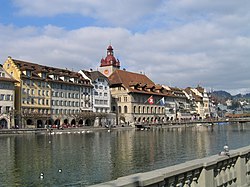| Central Switzerland | |
 | |
Location  | |
| State | Switzerland |
|---|---|
| Capital | Lamp |
| Surface | 4,483.3 km² |
| Inhabitants | 718.400 (2007) |
| Tourism site | |
Central Switzerland it is a geographic region.
To know
Central Switzerland (official name: Zentralschweiz) includes the canton of Lucerne, the canton of Uri, the canton of Schwyz, Obwalden, Nidwalden and the canton of Zug.
Geographical notes
Is composed by: canton of Lucerne, canton Uri, canton of Schwyz, Obwalden, Nidwalden. The geographic center of Switzerland is Älggi-Alp.
When to go
Central Switzerland has a climate dominated mainly by the Atlantic, but also by continental currents, with relatively strong temperature changes, rainfall is distributed throughout the year. The wettest month is July.
The best time to travel to the high mountains is summer. If you want to get to know the country and its people, art and cuisine, you should travel in May, June, September or October instead of the main months when the Swiss travel, namely July and August.
Background
Central Switzerland is considered the birthplace of Switzerland. The Federal Statute of 1291 documents a first alliance between the inhabitants of Uri, Schwyz and Unterwalden (divided into Ob- and Nidwalden). This document is still preserved and can be seen (along with many others) in the Swiss Confederation Map Museum in Schwyz. This region is also where events around the life of the legendary William Tell are presumed to have occurred. In the 14th century Lucerne joined the alliance, forming what is called the Vier Waldstätten (roughly translated as four forest cantons).
Spoken languages
Central Switzerland belongs to German-speaking Switzerland. The spoken Swiss-German dialects are among the most original Swiss. The Uri and Obwalden dialects are particularly striking for their archaic sounds and words. Exceptionally rustic and typical dialects are also spoken in remote valleys, such as Muotathal in the canton of Schwyz or the Schächental in the canton of Uri. The dialects of Lamp and Zug differ considerably from the rest of central Switzerland in this respect, as they are more Mediterranean and therefore have less archaic words.
Territories and tourist destinations

Urban centers
- Lamp - The main city in the region and certainly the most attractive for tourists.
- Andermatt - At the crossroads of the 4 communication axes, San Gottardo and Ticino to the south, Oberalp and the source of the Rhine to the east, the Furka pass and the Rhone glacier to the west, the Goschenen towards Altdorf to the north, towards the valley.
- Brunnen
- Pfäffikon
- Sarnen
- Stans - capital of the canton of Nidwalden
- Schwyz (Schwyz) - Old capital of Switzerland with a beautiful mother church and its square.
Other destinations
- Burgenstock - At 1,127 m a.s.l. a vantage point with views of Lucerne and the Lake Lucerne. Classified as a cultural property of national importance in Switzerland.
- Lake Lucerne
- Mount Titlis - Titlis is a mountain in the Bernese Alps in the canton of Obwalden. It is the highest mountain in the canton.
How to get
How to get around
There is a ferry between Beckenried and Gersau on the north bank of the Lake Lucerne.
What see
What to do
The region offers the traveler many options: relaxation, beautiful landscapes, historic centers and boat trips, just to name a few.
Numerous mountaineering schools (e.g. Engelberg, Braunwald and Andermatt) offer mountaineering courses for beginners and advanced.
Paragliding is also popular. There are many take-off sites (Stanserhorn, Brände, Klewenalp) and schools that also specialize in tandem flights.
On the largest lakes in central Switzerland, all with very good water quality, you can sail, surf, water ski, canoe, row and of course swim.
Events and parties
Central Switzerland is predominantly Catholic and consequently are the majority of public holidays. These listed are public holidays in addition to those observed throughout Switzerland:
- San Bertoldo, Lamp.
 January 2.
January 2. - Epiphany, Schwyz is Canton of Uri.
 January 6.
January 6. - Feast of St. Joseph, Nidwalden, Schwyz and Canton of Uri.
 March 19.
March 19. - Corpus Christi. 60 days after Easter.
- Feast of the Assumption.
 August 15.
August 15. - Feast of Brother Klaus, Obwalden.
 September 25.
September 25. - All Saints.
 November 1.
November 1. - Immaculate Conception.
 December 8.
December 8.
In the canton of Uri, December 26 is not a holiday if Christmas falls on a Monday.
At the table
Safety
Other projects
 Wikipedia contains an entry concerning Central Switzerland
Wikipedia contains an entry concerning Central Switzerland Commons contains images or other files on Central Switzerland
Commons contains images or other files on Central Switzerland
